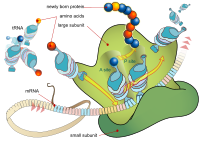
Photo from wikipedia
Pichia pastoris (Komagataella spp.) has become one of the most important host organisms for production of heterologous proteins of biotechnological interest, many of them extracellular. The protein secretion pathway has… Click to show full abstract
Pichia pastoris (Komagataella spp.) has become one of the most important host organisms for production of heterologous proteins of biotechnological interest, many of them extracellular. The protein secretion pathway has been recognized as a limiting process in which many roadblocks have been pinpointed. Recently, we have identified a bottleneck at the ER translocation level. In earlier exploratory studies, this limitation could be largely overcome by using an improved chimeric secretion signal to drive proteins through the co-translational translocation pathway. Here, we have further tested at bioreactor scale the improved secretion signal consisting of the pre-Ost1 signal sequence, which drives proteins through co-translational translocation, followed by the pro region from the secretion signal of the Saccharomyces cerevisiae α-factor mating pheromone. For comparison, the commonly used full-length α-factor secretion signal, which drives proteins through post-translational translocation, was tested. These two secretion signals were fused to three different model proteins: the tetrameric red fluorescent protein E2-Crimson, which can be used to visualize roadblocks in the secretory pathway; the lipase 2 from Bacillus thermocatenulatus (BTL2); and the Rhizopus oryzae lipase (ROL). All strains were tested in batch cultivation to study the different growth parameters obtained. The strains carrying the improved secretion signal showed increased final production of the proteins of interest. Interestingly, they were able to grow at significantly higher maximum specific growth rates than their counterparts carrying the conventional secretion signal. These results were corroborated in a 5 L fed-batch cultivation, where the final product concentration and volumetric productivity were also shown to be improved.
Journal Title: New biotechnology
Year Published: 2020
Link to full text (if available)
Share on Social Media: Sign Up to like & get
recommendations!